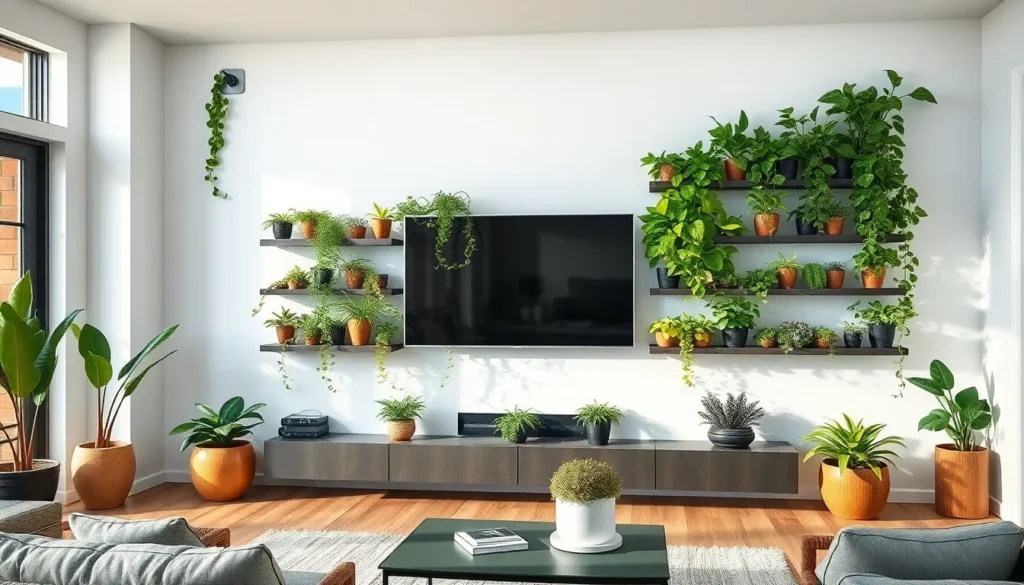We’ve all stared at that blank wall behind our TV wondering how to make it more visually appealing. The solution that’s taking interior design by storm combines the functionality of entertainment with the natural beauty of greenery – the TV wall with plants.
This trending design concept transforms your ordinary media wall into a stunning focal point that breathes life into your living space. By strategically incorporating plants around your television we create a harmonious balance between technology and nature that’s both Instagram-worthy and surprisingly practical.
Whether you’re working with a small apartment or spacious family room we’ll show you how plant-integrated TV walls can elevate your home’s aesthetic while improving air quality and creating a more relaxing atmosphere for your daily viewing experience.
Create a Living Green Frame Around Your Television
Building on the foundation of plant-integrated TV walls, we’ll explore how to create a stunning living frame that enhances your viewing experience while bringing natural beauty to your entertainment space.
Choose the Right Plant Varieties for Your TV Area
Low-maintenance succulents work perfectly for beginners creating their first plant TV wall. Varieties like jade plants, echeveria, and string of pearls require minimal watering and thrive in indoor conditions. These drought-tolerant options reduce maintenance while providing consistent greenery year-round.
Trailing plants create dramatic cascading effects around your television frame. Pothos, philodendrons, and spider plants naturally drape downward, softening the rectangular edges of your TV. Their flexible growth patterns allow easy adjustment as they mature.
Air-purifying plants serve dual purposes in your entertainment area. Snake plants, peace lilies, and rubber trees filter common household toxins while adding vertical interest to your display. Research shows these varieties remove formaldehyde and benzene from indoor air.
Compact flowering plants add seasonal color without overwhelming your viewing space. African violets, small orchids, and begonias provide blooms in controlled sizes. Their contained growth habits prevent interference with your television’s ventilation needs.
Plan Your Plant Placement Strategy
Symmetrical arrangements create balanced visual weight on both sides of your TV. We recommend placing identical plants or planters at equal distances from the screen center. This approach works especially well with modern, minimalist entertainment centers.
Asymmetrical layouts offer more ever-changing visual interest for contemporary spaces. Position larger plants on one side and cluster smaller varieties on the opposite side. This technique follows the rule of thirds, creating natural focal points.
Vertical shelving systems maximize your plant display area without expanding floor space. Install floating shelves above and beside your TV to accommodate multiple plant sizes. Stagger shelf heights to create depth and prevent a flat, uniform appearance.
Corner integration utilizes often-overlooked spaces near your entertainment center. Tall floor plants like fiddle leaf figs or dracaenas fill vertical corners while shorter plants occupy side table surfaces. This strategy creates a cohesive green environment.
Consider Lighting Requirements for Both Plants and Viewing
Natural light assessment determines which plants will thrive in your TV area. South-facing windows provide bright, direct light suitable for succulents and flowering plants. East or west-facing windows offer moderate light perfect for most houseplants.
Artificial lighting answers supplement natural light when your entertainment area lacks adequate sun exposure. LED grow lights designed for houseplants provide full-spectrum lighting without generating excessive heat. Position these lights to avoid screen glare during viewing.
Ambient lighting balance ensures comfortable viewing while supporting plant health. We suggest installing dimmer switches to adjust room lighting based on different activities. Bright task lighting works for plant care while subdued lighting enhances movie watching.
Heat management protects your plants from electronic equipment warmth. Maintain at least 12 inches between plants and heat-generating devices like cable boxes or gaming consoles. Adequate air circulation prevents moisture buildup that can damage both plants and electronics.
Design a Built-In Shelving System for Plants and Electronics
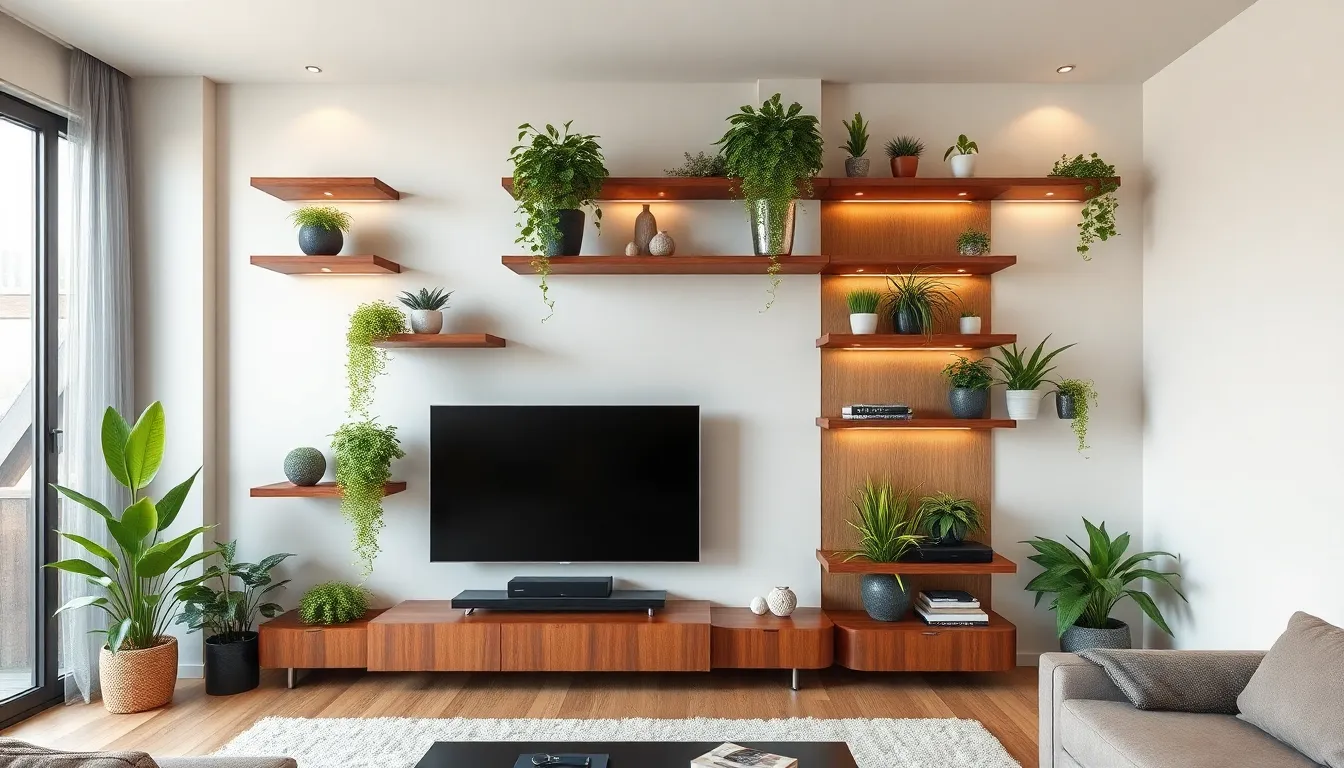
Creating a custom built-in shelving system maximizes your TV wall’s potential while seamlessly blending technology with nature. This approach transforms your entertainment area into a functional living display that accommodates both your electronic devices and botanical collection.
Incorporate Floating Shelves at Strategic Heights
Varying shelf heights creates visual interest while accommodating plants of different sizes around your television setup. We recommend positioning shelves at 18-inch intervals above and below your TV to establish a balanced composition that draws the eye naturally across the entire wall.
Accessibility remains crucial when determining shelf placement since you’ll need regular access for plant maintenance and electronics adjustments. Position frequently watered plants at waist height or below to prevent water drips from reaching higher electronic components.
Load distribution requires careful planning as you’ll be supporting both plant containers and electronic equipment on the same system. Install floating shelves with robust bracket systems rated for at least 50 pounds per linear foot to safely accommodate your combined weight requirements.
Visual spacing between shelves should allow trailing plants to cascade without interfering with your TV screen or blocking ventilation ports on nearby electronics. Leave minimum 24-inch clearances above and below your television for optimal plant growth and device cooling.
Add Hidden Cable Management Answers
Cable organizers integrated into your built-in design eliminate visual clutter while protecting cords from moisture damage caused by plant watering. We suggest installing cable management channels directly into the shelving structure during construction for the cleanest appearance.
Built-in conduits routed through shelf supports provide invisible pathways for power cables and data connections to reach your electronics. These channels should include removable covers for easy access during equipment changes or maintenance procedures.
Cord protection becomes essential when combining plants and electronics since water exposure can damage cables and create safety hazards. Use waterproof cable sleeves or grommets where cords pass through areas prone to moisture from plant care activities.
Power distribution planning prevents the need for visible extension cords by incorporating built-in outlets at strategic shelf locations. Install GFCI-protected outlets near plant areas to ensure electrical safety in moisture-prone zones.
Include Proper Drainage Systems for Plant Care
Waterproof liners installed under each planter prevent water damage to your shelving materials and protect electronic components below. We recommend using custom-fitted drainage trays that complement your shelf design while providing adequate water collection capacity.
Drainage channels carved into shelf surfaces direct excess water away from sensitive electronic areas toward designated collection points. These subtle grooves should slope at minimum 1/4 inch per foot to ensure proper water flow without creating obvious visual interruptions.
Moisture barriers applied between plant areas and electronics create additional protection layers against humidity and accidental water exposure. Install these barriers as permanent features during construction rather than temporary answers that may fail over time.
Water collection systems positioned at the base of your shelving unit capture overflow from upper plant levels before it can damage flooring or nearby equipment. Consider integrating these collectors into your overall design aesthetic rather than using visible catch basins that detract from your display’s appearance.
Select Low-Maintenance Plants That Thrive in TV Room Conditions
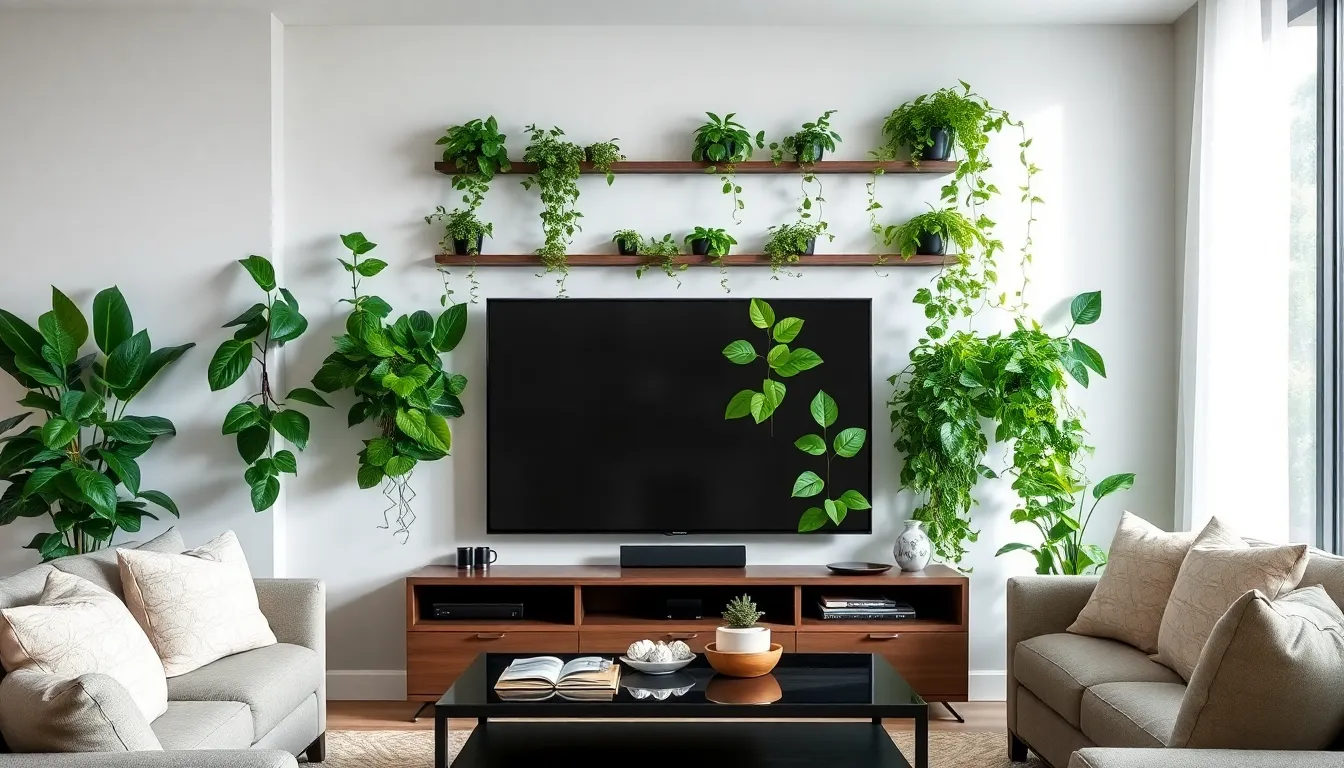
TV rooms present unique environmental challenges with their low to moderate light conditions and variable humidity levels. We need plants that can flourish in these exact conditions while requiring minimal care.
Opt for Air-Purifying Indoor Plants
Air-purifying plants serve a dual purpose by improving your TV wall’s visual appeal while actively cleaning indoor air pollutants. Philodendrons excel in this category, tolerating low light conditions while removing harmful toxins from frequently occupied TV rooms. These versatile plants require watering only when soil dries and can grow tall to create striking vertical features on your media wall.
English Ivy stands out as another excellent air-purifying choice that thrives in humidity without needing bright sunlight. We recommend this plant for less sunny TV spaces since it maintains its lush appearance under challenging lighting conditions. The cascading nature of English Ivy adds natural movement to static wall displays while continuously working to improve your room’s air quality.
Choose Plants That Handle Artificial Light Well
Artificial lighting dominates most TV rooms, making light-tolerant plants essential for successful wall displays. Spiderwort (Tradescantia) adapts beautifully to both direct and bright indirect light, making it perfect for rooms with mixed lighting sources. This rapid-growing plant keeps soil consistently moist and flourishes in hanging pots positioned strategically around your TV wall.
Pink Princess Philodendron tolerates low light conditions while displaying vibrant colors when placed under bright indirect light. We’ve found this plant particularly effective near artificial light sources since it maintains its striking appearance without demanding exact natural light requirements. The plant’s tall growth pattern creates dramatic vertical interest that complements modern TV wall designs.
Consider Trailing Plants for Vertical Interest
Trailing plants transform flat TV walls into ever-changing displays by adding cascading greenery that softens hard electronic edges. Spiderwort’s trailing vines grow rapidly and create lush vertical layers that don’t demand extensive care routines. We position these plants on shelves or wall-mounted planters above the TV area to maximize their dramatic cascading effect.
English Ivy trails gracefully around TV installations, creating natural frames that enhance the viewing experience. This low-maintenance option thrives in typical TV room humidity levels while adding sophisticated green layers to your entertainment space. The plant’s ability to cascade down shelving systems makes it ideal for creating cohesive plant arrangements that connect different levels of your TV wall display.
Install Proper Grow Lights for Your TV Wall Garden
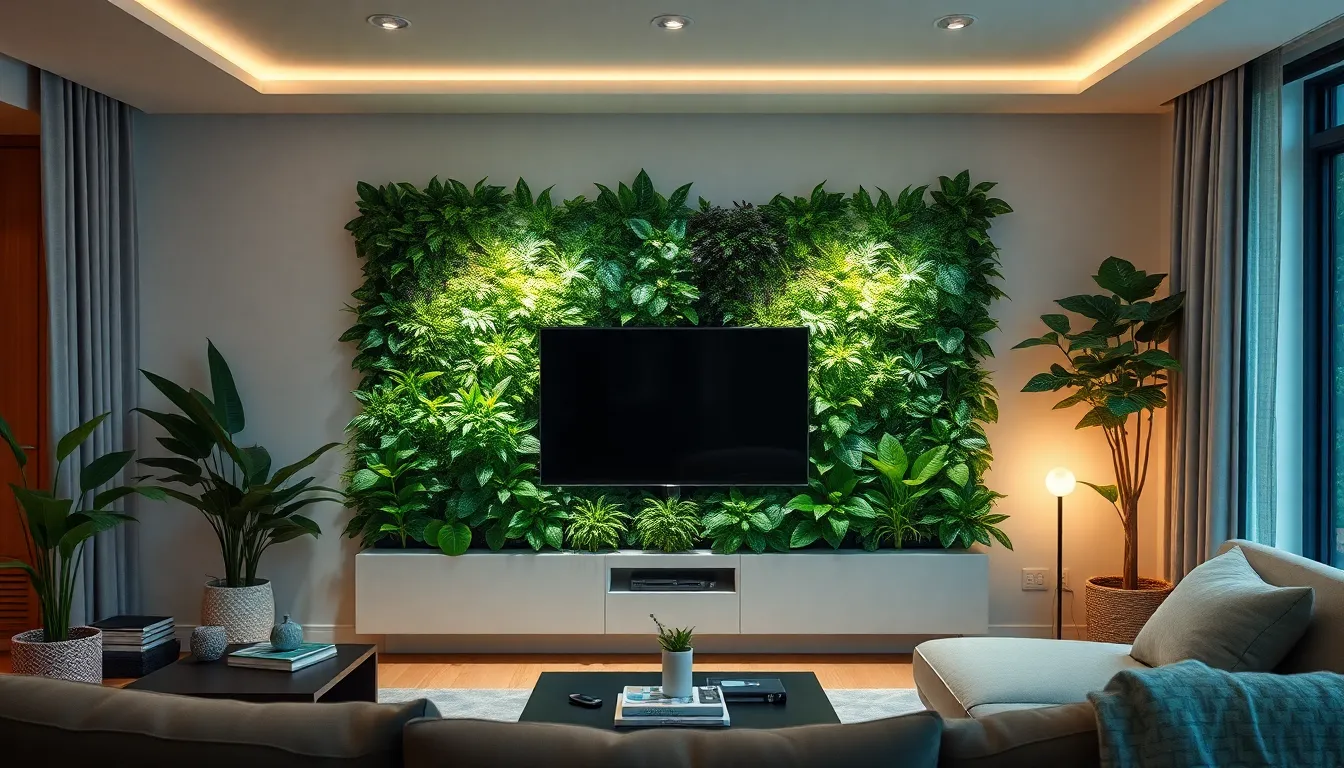
After selecting the perfect low-maintenance plants for your TV wall garden, we need to ensure they receive adequate lighting to thrive. LED grow lights are the most effective solution for plant-integrated entertainment spaces due to their energy efficiency and full spectrum capabilities.
Position LED Grow Lights Strategically
Vertical alignment creates the foundation for successful plant growth around your TV wall setup. We recommend positioning LED grow lights to face the vertical wall garden directly, ensuring even light distribution across all plant levels. Strategic placement involves mounting lights at multiple heights to accommodate different plant sizes and growth patterns.
Adjustable intensity features allow us to customize light levels for various plant species within the same display. Plants positioned closer to the TV require different light intensities than those placed on outer shelves. Distance calculations become crucial when we position lights 12 to 18 inches away from foliage to prevent leaf burn while maximizing photosynthesis.
Coverage angles determine how effectively our lights reach all planted areas. Full spectrum LED panels with 120-degree beam angles provide comprehensive coverage for wall-mounted arrangements. Multiple light sources eliminate shadows and dark spots that can inhibit plant growth in complex TV wall configurations.
Balance Ambient Lighting with Plant Needs
Room lighting coordination ensures our plants receive consistent illumination without creating viewing discomfort. We must consider how natural window light interacts with artificial grow lights throughout the day. Evening viewing sessions require dimmer ambient lighting while maintaining adequate plant illumination through dedicated grow light systems.
Light spectrum management involves selecting grow lights that complement existing room lighting rather than competing with it. Warm white LED grow lights blend seamlessly with home lighting while providing essential red and blue wavelengths plants need. Cool white options work better in modern spaces with bright ambient lighting.
Visual comfort becomes essential when we integrate grow lights into entertainment areas. Positioning lights behind plants or using diffusers prevents direct glare during TV watching. Shield placement and directional adjustments help us maintain optimal plant lighting without compromising viewing comfort.
Use Timer Systems for Automated Plant Care
Automated scheduling eliminates guesswork and ensures consistent plant care in our TV wall gardens. Timer systems provide plants with 14 hours of light and 10 hours of darkness to mimic natural day/night cycles. Digital timers offer precise control over lighting schedules, allowing us to adjust timing based on seasonal changes and plant requirements.
Consistency maintenance through automated systems reduces manual effort while improving plant health outcomes. Plants respond better to regular lighting schedules than sporadic manual adjustments. Smart timer integration allows us to monitor and adjust lighting remotely, ensuring our TV wall garden receives proper care even when we’re away.
Energy efficiency improves significantly when we use programmable timers with our LED grow light systems. Automated controls prevent lights from running unnecessarily, reducing electricity costs while maintaining optimal plant growing conditions. Multiple timer zones let us customize lighting schedules for different plant groupings within the same TV wall display.
Create Visual Balance Between Technology and Nature
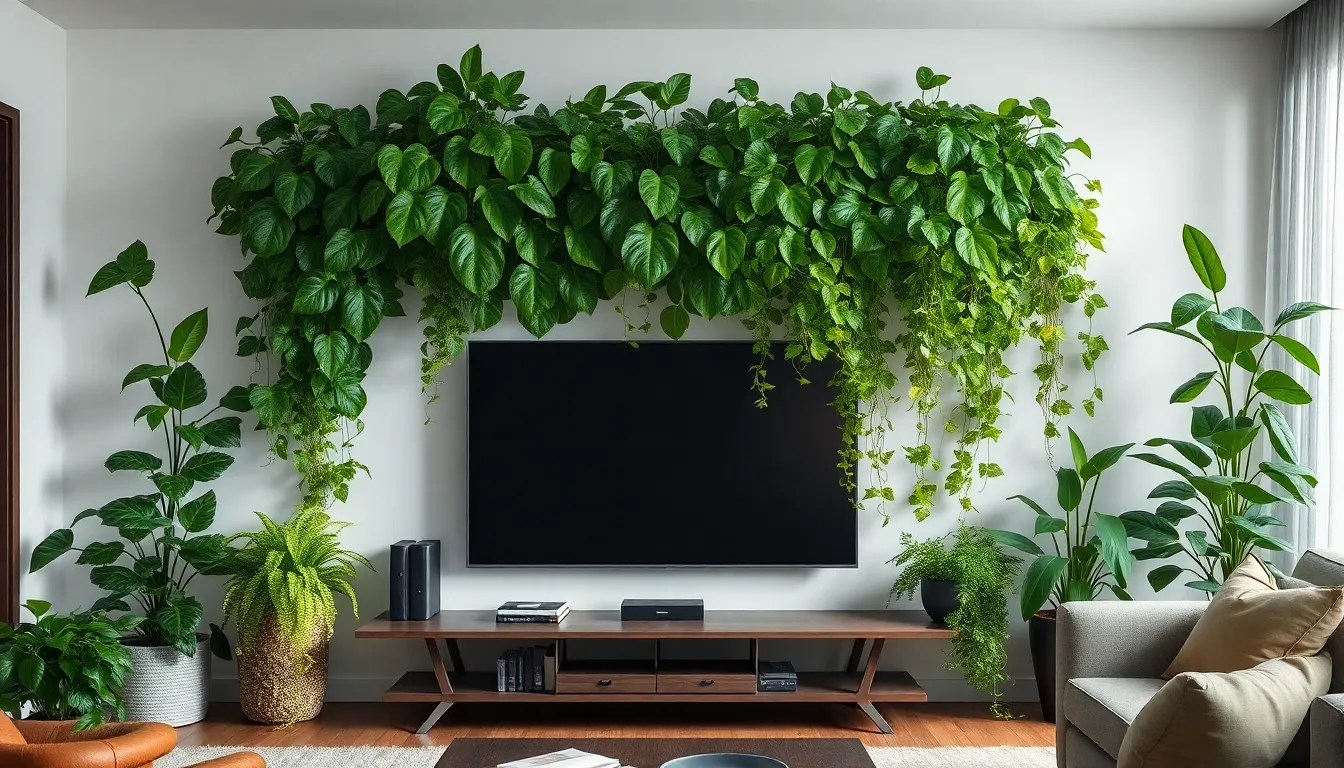
Balancing technology with natural elements requires strategic placement that allows both the TV and plants to complement rather than compete with each other. We’ll position greenery to soften the harsh edges of electronic devices while maintaining clear focus on the screen itself.
Apply the Rule of Thirds for Plant Arrangement
Dividing your TV wall into thirds both horizontally and vertically creates natural focal points for plant placement. We position larger plants at the intersection points where these imaginary lines meet, creating a balanced composition that guides the eye naturally across the wall. This strategic arrangement prevents our plant display from appearing cluttered or randomly placed.
Following the division lines themselves offers additional placement opportunities for smaller plants. We arrange trailing vines along the vertical thirds to create height variation, while positioning compact succulents or air plants along the horizontal divisions. This systematic approach ensures our greenery enhances rather than overwhelms the television’s presence.
Maintaining consistent spacing between plants according to the rule of thirds prevents visual chaos. We avoid cramming multiple plants into one section while leaving others bare, instead distributing our botanical elements evenly across the designated grid lines. This creates a professional, intentional look that elevates the entire wall design.
Mix Different Plant Heights and Textures
Incorporating varying plant heights adds dimensional depth to our TV wall arrangement. We position taller plants like Fiddle Leaf Figs or Snake Plants on either side of the television to create natural bookends, while placing medium height plants such as Philodendrons on floating shelves at different levels. This layered approach transforms a flat wall into a ever-changing living display.
Combining different leaf textures creates visual interest without competing with the screen. We pair broad leafed plants like Monstera with fine textured varieties such as Ferns or String of Hearts to establish contrast. This textural variety adds sophistication while maintaining harmony within the overall design scheme.
Trailing plants introduce organic movement that softens technological edges. We allow Pothos or English Ivy to cascade from upper shelves, creating natural lines that flow around the TV mount. These flowing elements balance the rigid rectangular shape of the television while adding vertical interest to the composition.
Maintain Proper Viewing Angles and Distances
Preserving clear sightlines requires careful consideration of plant placement relative to seating positions. We ensure no foliage blocks the screen from primary viewing angles by positioning taller plants at least 2 feet to either side of the television. This maintains optimal viewing experience while allowing plants to frame the display effectively.
Managing light reflection prevents glare issues that compromise viewing comfort. We avoid placing glossy leafed plants like Rubber Trees directly adjacent to the screen where they might reflect room lighting onto the display. Instead, we position these varieties further from the television or choose plants with matte leaf surfaces for closer placement.
Calculating proper distances prevents plants from overwhelming the viewing area. We maintain a minimum clearance of 18 inches between any plant and the TV screen to ensure comfortable sight lines from standard seating distances. This spacing allows us to enjoy both the natural beauty of our plants and clear, unobstructed entertainment viewing.
Incorporate Hanging Plants for Vertical Garden Appeal
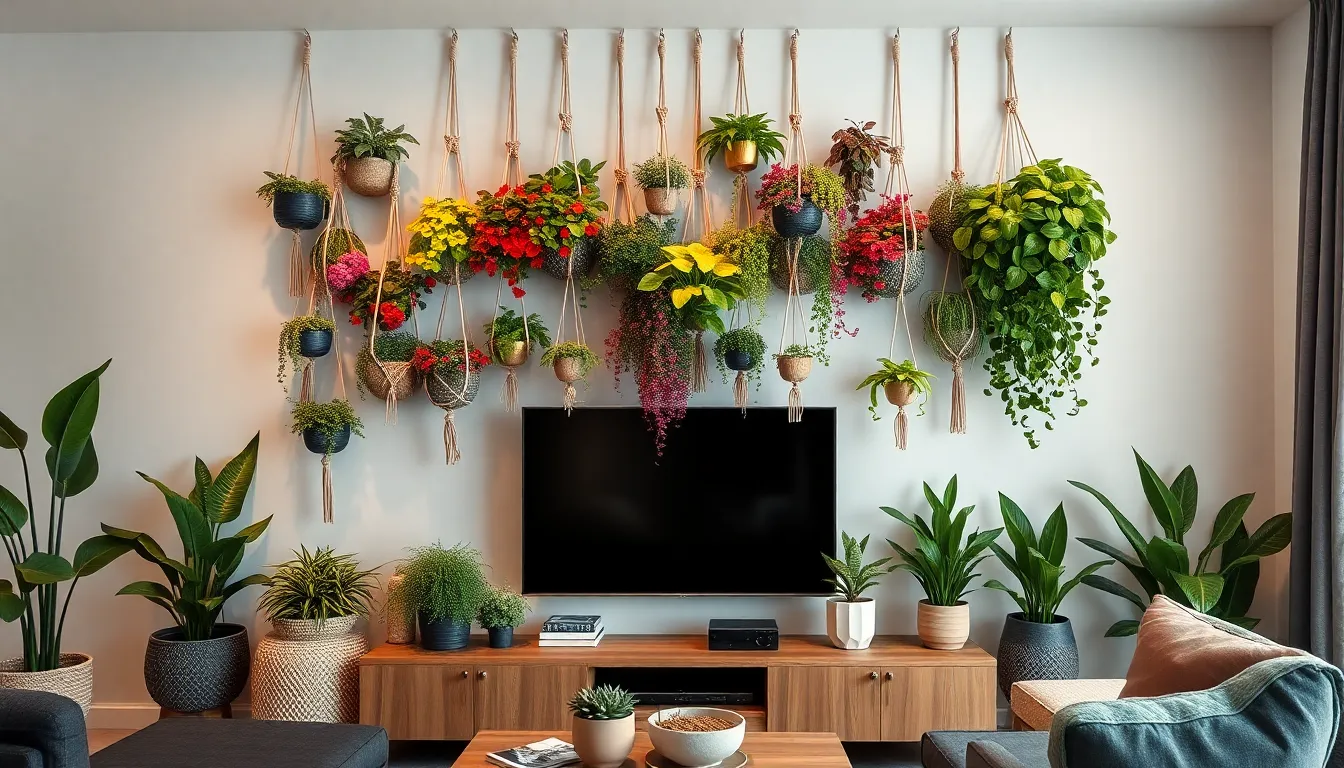
Hanging plants transform our TV wall into a ever-changing vertical garden that draws the eye upward and creates impressive visual depth. We can achieve this stunning effect through several strategic approaches that maximize our space while adding natural beauty.
Use Macrame Hangers for Bohemian Style
Macrame plant hangers introduce an artisanal bohemian aesthetic that perfectly complements our natural TV wall design. We can select from various macrame patterns including spiral knots, diamond patterns, and simple braided designs to match our room’s existing decor style.
Cotton rope macrame hangers offer the most versatile option since they work well with both modern and traditional interior designs. We should choose hangers in different lengths ranging from 24 to 48 inches to create visual variety and accommodate plants of various sizes.
Handcrafted macrame hangers using recycled materials like old t-shirts or fabric strips add an eco-friendly element to our TV wall garden. We can experiment with colored rope or natural jute to create contrast against our wall color while maintaining the organic feel of our plant display.
Install Ceiling Hooks for Trailing Varieties
Ceiling hooks provide the perfect anchoring system for long trailing plants that create dramatic cascading effects around our TV area. We need to install heavy-duty hooks rated for at least 15-20 pounds to safely support larger planters filled with soil and water.
Toggle bolts work best for drywall installations while eye screws secure directly into ceiling joists for maximum support. We should position hooks 12-18 inches away from the TV to prevent plants from interfering with viewing angles or ventilation.
Adjustable pulley systems allow us to easily raise and lower our hanging plants for maintenance without removing them completely. We can install these systems using ceiling tracks or individual pulley hooks that accommodate plants of varying weights and sizes.
Trailing varieties like English Ivy, Spiderwort, and Heartleaf Philodendron thrive in hanging positions and create beautiful green curtains that frame our TV naturally. We should select plants with different leaf textures and growth patterns to add visual interest and prevent our display from looking monotonous.
Create Layered Depth with Suspended Planters
Suspended planters at multiple heights generate impressive three-dimensional depth that transforms our flat TV wall into a living art installation. We can hang planters at staggered heights using 12-inch intervals to create natural-looking layers that mimic forest canopy levels.
Large planters positioned at eye level serve as anchor points while smaller suspended containers fill in gaps and add delicate details. We should combine 8-inch, 6-inch, and 4-inch planters to establish proper scale relationships that feel balanced and intentional.
Lightweight materials like fiberglass, plastic, or woven baskets prevent excessive weight while maintaining durability for long-term use. We can mix planter materials and textures including ceramic, metal, and natural fiber to create visual variety without overwhelming our space.
Different plant sizes and growth habits in our suspended arrangement add texture and movement as air circulation gently sways the hanging elements. We should include compact plants like small ferns in upper positions and fuller trailing varieties in lower spots to create natural-looking plant communities around our TV wall.
Add a Statement Plant Wall Behind Your Television
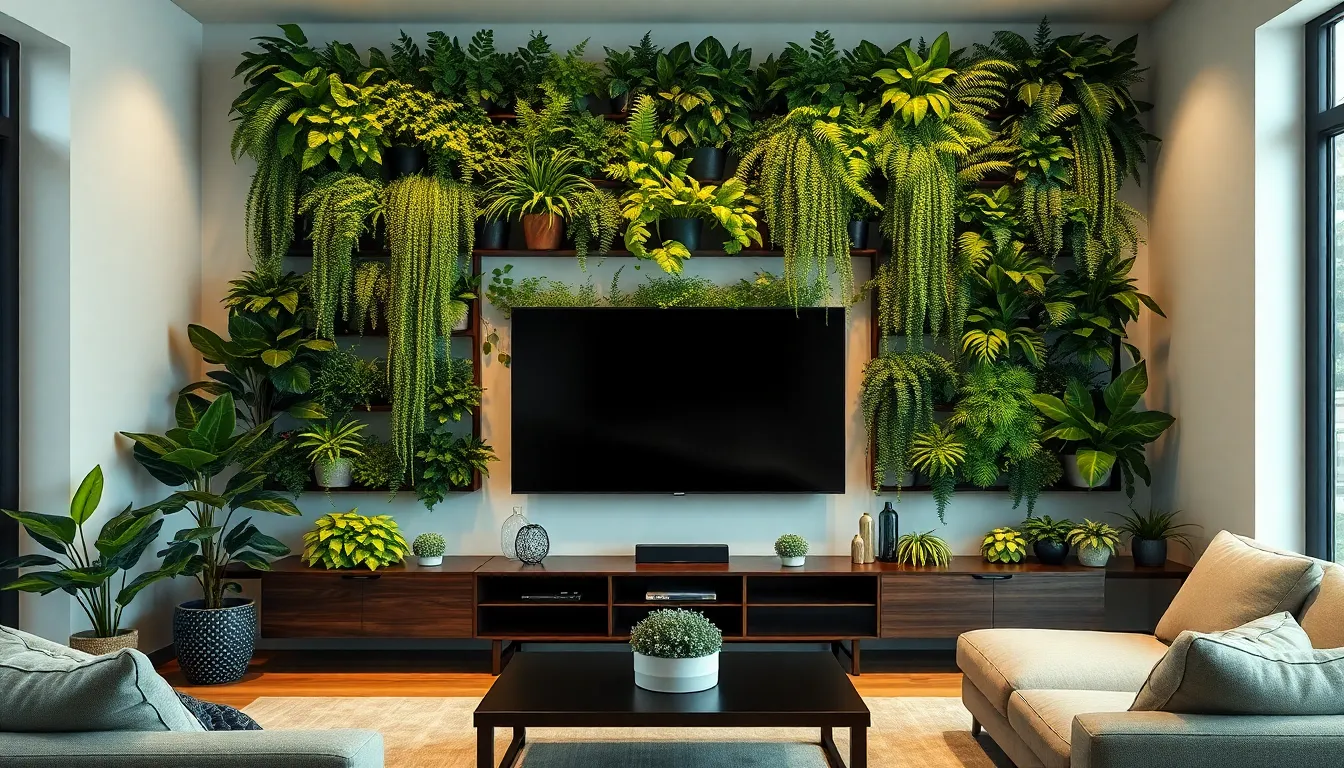
Creating a statement plant wall behind your TV transforms an ordinary entertainment area into a stunning natural focal point. This living backdrop enhances indoor air quality while softening the harsh lines of electronic equipment with vibrant botanical textures.
Install Modular Living Wall Systems
Modular living wall systems offer the most professional and flexible approach to creating your TV plant wall. These engineered answers consist of interconnected panels or pocket planters that mount securely to any wall surface. We recommend systems like the Platipus G-WALL®, which assembles quickly with basic tools and expands both vertically and horizontally to fit your space perfectly.
Professional installation typically requires industry or irrigation expertise for optimal results. But, many modular kits allow DIY enthusiasts to tackle the project independently. Each system features sealed cells that protect your wall from moisture damage while providing integrated irrigation options for consistent plant care.
Plant Selection for Modular Systems:
- Flowers for seasonal color bursts
- Ferns for lush green textures
- Herbs for functional beauty
- Trailing species for dramatic cascading effects
These systems boast a 20-year design life, making them a worthwhile investment for your entertainment space. Installation flexibility allows you to start small and expand your living wall over time as your confidence and plant collection grows.
Create DIY Pocket Planters
DIY pocket planters provide an affordable and customizable alternative for your TV plant wall. These individual containers mount in creative grid patterns or flowing arrangements behind your television. We love this approach because you can remove and replant individual pots without disturbing the entire wall display.
Mounting pocket planters allows for ergonomic pre-planting on a workbench before installation. This method reduces the physical strain of working at wall height while ensuring each plant gets proper attention during setup. Each planter can house different plant varieties, creating visual interest through varied textures and colors.
Benefits of Pocket Planter Systems:
- Easy individual plant replacement
- Simplified maintenance access
- Custom arrangement flexibility
- Budget-friendly installation
- Expandable design options
Arrange your pocket planters in symmetrical patterns for formal spaces or create organic, flowing designs for relaxed environments. Mix different sized planters to add depth and visual movement to your TV wall backdrop.
Use Moss Walls for Low-Maintenance Options
Moss walls represent the ultimate low-maintenance solution for busy homeowners wanting natural beauty behind their TV. These installations require minimal watering and thrive in low-light indoor conditions, making them perfect for entertainment areas. Moss naturally absorbs sound, creating acoustic benefits that enhance your viewing experience.
Preserved moss panels maintain their soft, lush appearance without ongoing care requirements. These panels create stunning textured backdrops that complement modern electronics while adding organic warmth to your space. Installation involves mounting pre-made moss panels directly to your wall surface using appropriate hardware.
Moss Wall Advantages:
| Feature | Benefit |
|---|---|
| Minimal watering | Reduces maintenance time |
| Low light tolerance | Thrives in TV viewing areas |
| Sound absorption | Improves room acoustics |
| No pruning required | Zero ongoing plant care |
| Consistent appearance | Maintains beauty year-round |
Fresh moss walls require slightly more attention but offer ever-changing growth patterns and natural color variations. Both preserved and living moss options create sophisticated natural backdrops that elevate your entertainment space without demanding constant attention.
Style Your TV Wall with Decorative Planters and Pots
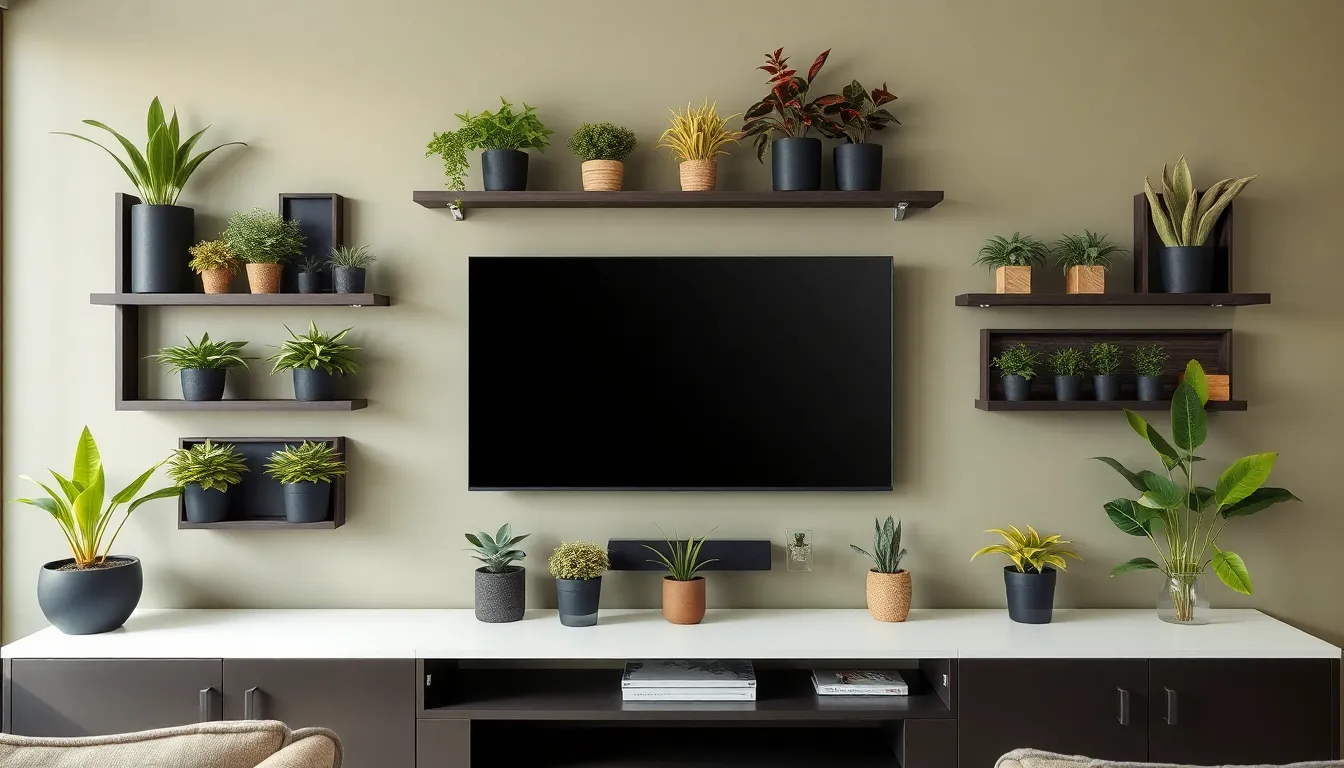
Creating a cohesive plant display around your TV requires thoughtful selection of planters that enhance rather than compete with your entertainment setup. We’ll transform your media wall into a sophisticated focal point by choosing the right containers and coordinating them with your existing decor.
Choose Planters That Complement Your Decor
Selecting planter materials and colors that harmonize with your furniture and wall color creates visual unity throughout your space. Matte black pots work exceptionally well with sleek modern TVs and stands, while natural wood planters suit warmer, cozy rooms perfectly.
Mixing planter shapes and sizes creates visual interest that draws the eye naturally around your TV wall. Taller pots with upright plants can frame the TV elegantly, while smaller, trailing plants soften sharp edges and add dimensional depth to your display.
Wall-mounted planters or shelves allow us to display plants around or behind the TV, making the greenery part of the room’s focal point without cluttering valuable surface space. Consider planters with designs and finishes that enhance your room’s existing décor, whether modern, rustic, or eclectic in style.
Mix Materials Like Ceramic, Wood, and Metal
Combining materials like ceramic, wood, and metal in your planters enriches the texture and visual appeal of your TV wall display. Ceramic pots offer smooth, colorful surfaces that can serve as decorative elements, while wooden planters bring natural warmth to the space.
Metal planters add a contemporary edge that complements modern electronics and can tie together other metallic accents in your room. Using different materials allows for layering various styles and can connect other room elements like furniture, lighting fixtures, or existing shelving systems.
We recommend incorporating at least two different materials to create depth without overwhelming the space. This approach ensures your plant display feels intentional and professionally curated rather than randomly assembled.
Use Color Coordination for Cohesive Design
Coordinating plant foliage colors with planter colors keeps your design cohesive and visually balanced. Neutral pot colors paired with vibrant plants create a striking yet harmonious look that won’t compete with your TV screen.
Alternatively, using pots that pick up accent colors from your room’s existing palette can unify the entire space visually. Consider how pillow colors, rug tones, or artwork hues can be reflected in your planter selection for maximum impact.
Greens, variegated leaves, and deep purples in plant foliage work beautifully when balanced with complementary container colors. This strategic color coordination ensures your TV wall plants enhance your viewing experience rather than distract from it.
Maintain Your TV Wall Plant Display Year-Round
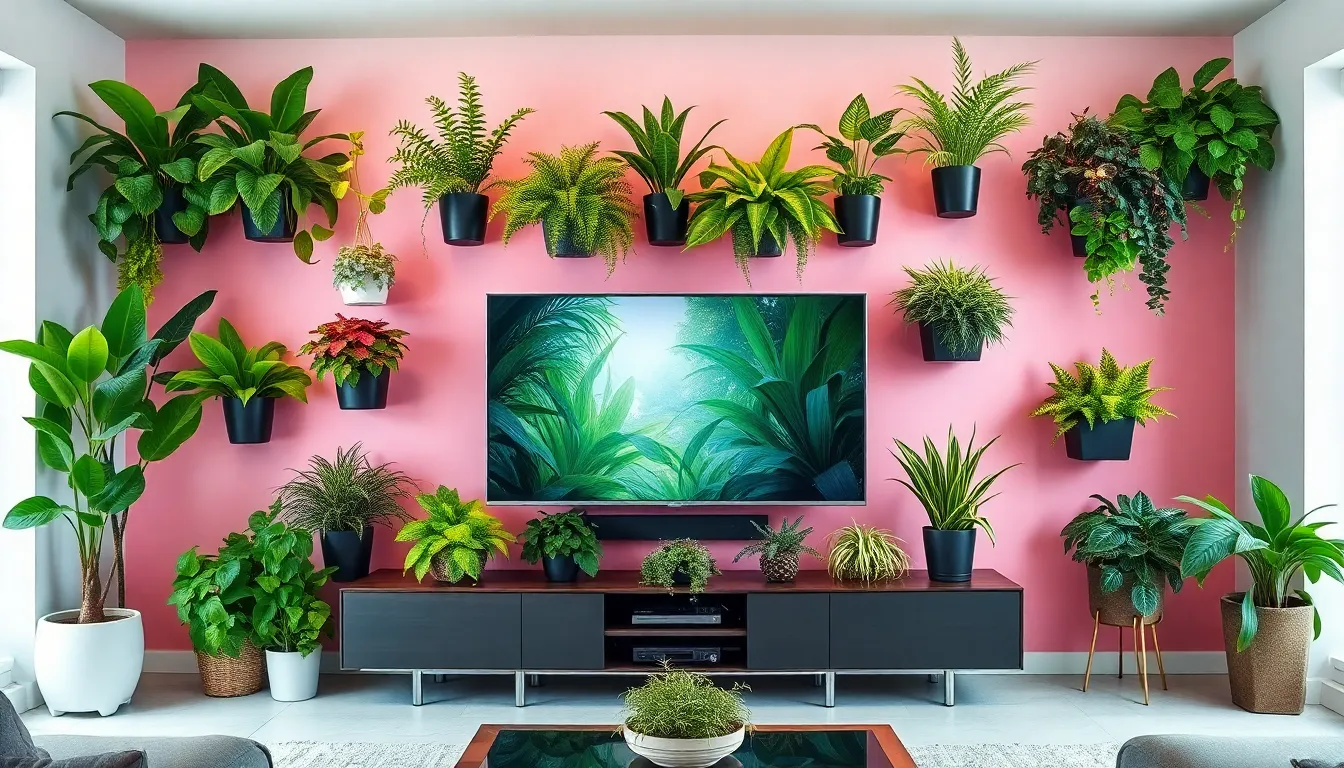
Keeping your TV wall plant display thriving requires consistent care and attention throughout the seasons. We’ll guide you through the essential maintenance practices that ensure your living wall remains healthy and beautiful.
Establish a Regular Watering Schedule
Frequency matters more than volume when watering plants on vertical surfaces. We recommend light, frequent watering sessions rather than deep, infrequent soaking to prevent root rot and maintain optimal moisture levels.
Drainage becomes critical for wall-mounted plant displays. Always use pots with proper drainage holes to allow excess water to escape and protect both your plants and wall from water damage.
Removable planters offer the safest approach for TV wall maintenance. We suggest using containers that can be easily removed for watering, which prevents moisture from damaging your electronics or wall structure.
Rainwater provides superior nutrition compared to tap water for your plants. This natural option lacks the chlorine and chemicals found in municipal water supplies, promoting healthier growth and vibrant foliage.
Monitor Plant Health and Growth Patterns
Bi-monthly inspections catch problems early before they become serious issues. We schedule regular check-ups to identify pest infestations, disease symptoms, or nutrient deficiencies that could compromise your display.
Leaf cleaning enhances photosynthesis and prevents bacterial buildup on plant surfaces. Dust accumulation blocks light absorption and creates an environment where harmful microorganisms can thrive.
Pruning promotes new growth while maintaining the neat appearance of your TV wall. We remove dead or dying stems and leaves to redirect the plant’s energy toward healthy development and attractive foliage.
Growth pattern tracking helps optimize placement of individual plants within your display. Some species may outgrow their designated spaces faster than others, requiring strategic repositioning.
Rotate Plants Seasonally for Optimal Growth
Seasonal rotation addresses changing light requirements as natural daylight patterns shift throughout the year. Different plant species have varying preferences for light intensity and temperature ranges.
Stress reduction occurs naturally when we provide each plant with ideal growing conditions during exact seasons. This practice prevents any single species from struggling in suboptimal conditions for extended periods.
Strategic replacement maintains visual appeal when certain plants show signs of decline even though proper care. We use seasonal rotation as an opportunity to refresh the display with healthy specimens that complement the current growing conditions.
Plant diversity thrives when we accommodate the natural preferences of different species through thoughtful seasonal adjustments. This approach creates a ever-changing living wall that evolves with the changing seasons while maintaining its beauty year-round.
Conclusion
We’ve shown you how a TV wall with plants can transform your entertainment space into a living masterpiece that balances technology with nature’s beauty. This design approach isn’t just about aesthetics—it’s about creating a healthier more relaxing environment where you’ll actually want to spend time.
The key to success lies in choosing the right plants for your space and maintaining them properly throughout the year. Whether you opt for a full living wall system or simple decorative planters your plant-integrated TV wall will become the focal point that brings life to your room.
Start small with low-maintenance options and gradually expand your green display as you gain confidence. Your TV wall doesn’t have to be just functional—it can be a stunning reflection of your personal style while improving your home’s air quality and ambiance.
Frequently Asked Questions
What are the main benefits of integrating plants into a TV wall?
Plant-integrated TV walls offer multiple advantages including improved indoor air quality, enhanced visual appeal, and better relaxation while viewing. They create a harmonious balance between technology and nature, transforming a plain media wall into an attractive focal point. The greenery also helps soften harsh electronic lines and can provide sound absorption for better acoustics.
Which plants work best for TV wall integration?
Low-maintenance varieties are ideal for beginners, including succulents, trailing plants like pothos, and air-purifying species such as snake plants or peace lilies. Compact flowering plants add seasonal color without overwhelming the space. Choose plants that thrive in your specific lighting conditions and don’t require frequent watering to minimize maintenance near electronics.
How do I manage lighting requirements for plants near my TV?
Balance natural and artificial light sources to support plant health while maintaining comfortable viewing conditions. Consider LED grow lights for plants that need more illumination, positioning them to avoid screen glare. Monitor how room lighting affects both plant growth and TV visibility, adjusting placement or adding supplemental lighting as needed.
What’s the best way to arrange plants around a TV wall?
Use symmetrical arrangements for a balanced, formal look or asymmetrical layouts for visual interest and modern appeal. Incorporate floating shelves at strategic heights, utilize corner spaces, and consider vertical shelving systems to maximize display areas. Ensure easy access for plant maintenance and electronics adjustments when planning your layout.
How do I protect electronics from plant moisture?
Install proper drainage systems with waterproof trays beneath planters to prevent water damage. Use removable planters for easy maintenance and choose pots with adequate drainage holes. Maintain safe distances between plants and electronics, and consider using moisture barriers or sealed shelving to protect sensitive equipment from humidity.
What are modular living wall systems and how do they work?
Modular living wall systems like the Platipus G-WALL® offer professional, flexible solutions for creating plant walls with integrated irrigation. These systems feature interlocking panels that can be customized to fit your space, often including automatic watering capabilities. They provide a clean, organized appearance while simplifying maintenance compared to individual planters.
Are moss walls a good option for TV wall backgrounds?
Yes, moss walls are excellent low-maintenance options that thrive in low-light conditions and provide natural sound absorption. Both preserved and fresh moss create sophisticated backdrops without requiring constant attention. Preserved moss needs minimal care, while fresh moss may need occasional misting, making either choice suitable for entertainment spaces.
How often should I maintain my TV wall plant display?
Establish a regular watering schedule based on your plants’ needs, typically weekly for most species. Conduct bi-monthly health inspections, cleaning leaves and pruning as needed. Rotate plants seasonally to address changing light requirements and maintain visual appeal. Regular maintenance prevents issues and keeps your living wall thriving year-round.
What types of planters work best for TV wall displays?
Choose decorative planters that complement your decor, mixing materials like ceramic, wood, and metal for visual interest. Ensure proper drainage and select sizes appropriate for your plants and space. Coordinate colors between foliage and planters for a harmonious look. Removable planters make maintenance easier and protect your wall from moisture damage.
Can I create a plant TV wall on a budget?
Absolutely! DIY pocket planters offer a customizable, budget-friendly alternative to expensive systems. Use repurposed materials, start with affordable plants like pothos or succulents, and build your display gradually. Simple floating shelves and basic planters can create an impressive look without significant investment while allowing for future expansion.

